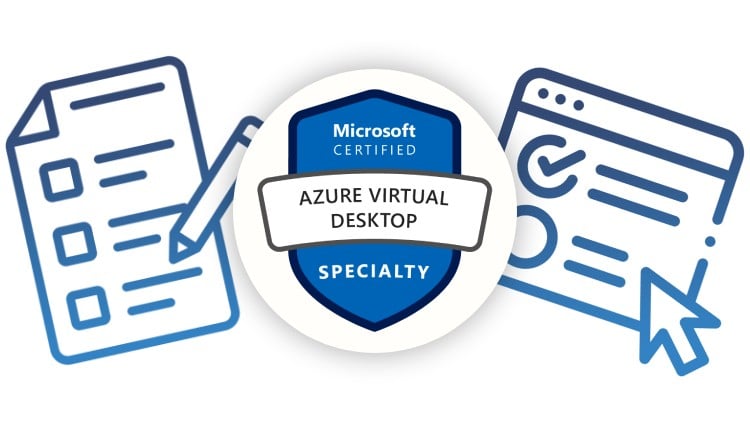
Prepare the AZ-140 Configuring and Operating MS Azure Virtual Desktop. 110 unique high-quality test with explanations!
⭐ 3.88/5 rating
👥 1,396 students
🔄 June 2025 update
Add-On Information:
Note➛ Make sure your 𝐔𝐝𝐞𝐦𝐲 cart has only this course you're going to enroll it now, Remove all other courses from the 𝐔𝐝𝐞𝐦𝐲 cart before Enrolling!
-
Course Overview
- This comprehensive course is meticulously designed to prepare you for the AZ-140: Configuring and Operating Microsoft Azure Virtual Desktop certification exam. It provides a deep dive into Microsoft’s robust cloud-based desktop and application virtualization service, covering essential architectural components, deployment strategies, and operational best practices. You will gain a thorough understanding of how AVD revolutionizes remote work, offering a flexible, cost-effective, and secure solution for delivering personalized desktops and remote applications. The content is rigorously updated to reflect the latest Azure features and exam objectives as of June 2025, ensuring you are equipped with the most current knowledge and practical skills for real-world AVD deployments.
-
Requirements / Prerequisites
- A foundational understanding of Microsoft Azure services, including familiarity with core concepts like virtual machines, virtual networks, storage accounts, and Azure Active Directory, is highly recommended to maximize your learning experience.
- Basic knowledge of Windows client and server operating systems, including user profiles and administration tasks, will provide a solid background for understanding AVD components.
- An awareness of virtualization concepts and traditional desktop infrastructure (VDI) will help contextualize AVD’s benefits.
- Familiarity with PowerShell scripting is advantageous for automation tasks, though key commands will be demonstrated.
- Access to an Azure subscription with sufficient privileges is strongly encouraged for practical, hands-on labs.
- A willingness to engage with technical documentation and troubleshooting will be beneficial.
-
Skills Covered / Tools Used
- Planning and Architecting Azure Virtual Desktop Environments: Learn to design optimal AVD architectures, including host pool strategies, network topology, storage (Azure Files, Azure NetApp Files), and identity integration with Azure Active Directory.
- Deploying and Configuring Host Pools and Session Hosts: Master creating and managing host pools, provisioning Windows client/server OS as session hosts, and configuring custom images using Azure Compute Gallery.
- Managing User Profiles with FSLogix: Implement and configure FSLogix Profile and ODFC Containers for seamless, persistent user experiences across non-persistent session hosts, covering storage integration and performance.
- Publishing and Managing Applications and Desktops: Learn to create application groups, publish remote apps and full desktop experiences, and manage user assignments for controlled access within the AVD workspace.
- Securing Azure Virtual Desktop Deployments: Implement robust security using Network Security Groups (NSGs), Azure Firewall, Conditional Access, Multi-Factor Authentication (MFA), and Azure Role-Based Access Control (RBAC) to protect your AVD infrastructure.
- Monitoring, Performance, and Optimization: Utilize Azure Monitor, Log Analytics, and performance counters to effectively monitor AVD, identify bottlenecks, troubleshoot, and implement scaling plans (autoscale).
- Implementing and Managing MSIX App Attach: Gain expertise in packaging and delivering applications dynamically with MSIX App Attach, enhancing application management flexibility and reducing image complexity.
- Automating AVD Operations: Leverage PowerShell, Azure CLI, and Azure Resource Manager (ARM) templates to automate routine deployment, configuration, and management tasks, improving efficiency and consistency.
- Troubleshooting Common AVD Issues: Develop practical skills in diagnosing and resolving connectivity, performance, user profile, and application delivery failures within AVD.
-
Benefits / Outcomes
- AZ-140 Certification Success: Confidently pass the AZ-140 exam, earning a valuable industry-recognized certification.
- Master AVD Deployment & Management: Achieve proficiency in designing, implementing, and maintaining scalable, secure, and cost-effective Azure Virtual Desktop solutions.
- Enhanced Career Opportunities: Become a highly sought-after cloud virtualization specialist, advancing your career in cloud computing and remote work.
- Operational Efficiency & Cost Savings: Optimize resource utilization, implement auto-scaling, and manage profiles/applications to reduce overhead and achieve significant cost savings.
- Superior User Experience Delivery: Ensure a consistent, high-performance, and secure virtual desktop experience for end-users, enhancing productivity and satisfaction.
- Robust Security Posture for Remote Work: Implement advanced security controls, identity management, and compliance measures within AVD to protect data.
- Troubleshooting & Problem-Solving Expertise: Develop critical skills to swiftly identify, diagnose, and resolve complex AVD issues.
- Strategic Cloud Adoption: Contribute to your organization’s cloud adoption by leveraging AVD to modernize desktop infrastructure and support hybrid work.
-
PROS
- Comprehensive Exam Coverage: Meticulously aligns with the official AZ-140 exam blueprint, ensuring all topics for certification success are thoroughly addressed.
- Extensive Practice Tests: 110 unique, high-quality test questions with detailed explanations help assess understanding and build exam confidence.
- Timely Content Updates: The “June 2025 update” guarantees the course material reflects the latest Azure Virtual Desktop features, best practices, and exam objectives.
- Strong Student Validation: A solid 3.88/5 rating from 1,396 students signifies a highly regarded and effective learning experience, validating its quality.
- Practical Skill Development: Emphasizes hands-on application, enabling real-world skills in configuring and operating Azure Virtual Desktop.
- Career Advancement Potential: Equips individuals with a specialized and highly demanded skill set, enhancing career prospects in cloud infrastructure and VDI.
-
CONS
- Self-Paced Learning Requires Discipline: Success in this self-paced course heavily relies on the individual learner’s self-discipline and ability to allocate dedicated time for study and hands-on practice, which may be challenging for some.
Learning Tracks: English,IT & Software,IT Certifications
Found It Free? Share It Fast!